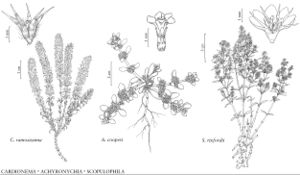Scopulophila
Contr. W. Bot. 12: 5. 1908.
| Taxon | Illustrator ⠉ | |
|---|---|---|
 | Cardionema ramosissimum Achyronychia cooperi Scopulophila rixfordii | Yevonn Wilson-Ramsey Yevonn Wilson-Ramsey Yevonn Wilson-Ramsey |
Herbs, perennial, dioecious, with thick, woody crown. Taproots stout. Stems ascending to erect, branched distally, terete to angular, base densely woolly. Leaves opposite, connected by thickened ridge or transverse wing from which stipules arise, sessile; stipules 2 per node, white, triangular, margins jagged to ciliate, apex entire to 2-lobed; blade obscurely 1-veined, linear to lanceolate, somewhat succulent, apex acute to apiculate. Inflorescences reduced axillary cymes, proliferating with age; bracts paired, resembling stipules, smaller, scarious. Flowers functionally unisexual, sessile; hypanthium conic to urceolate, abruptly expanded distally; sepals 5, distinct, green, linear-elliptic to orbiculate, 1.1–2.1 mm, herbaceous, margins white, scarious, apex broadly rounded, not hooded, not awned; nectaries minute, reddish thickenings adaxially subtending filament bases; stamens 5, abortive or sterile in pistillate flowers; filaments distinct to base; staminodes 5, arising from hypanthium rim, alternating with stamens, petaloid, oblong; ovary sterile in staminate flowers; styles 3, connate in proximal 1/3–2/3, filiform, ca. 1.5 mm, glabrous proximally; stigmas 3, linear along adaxial surface of styles, obscurely papillate (50×). Modified utricles ellipsoid, opening by 3 spreading, minute, toothlike valves. Seeds tan with red spot near one end, ovoid, slightly laterally compressed, minutely roughened, marginal wing absent, appendage absent; embryo central, straight to slightly curved.
Distribution
sw United States, Mexico
Discussion
Species 2 (1 in the flora).
The second species, Scopulophila parryi (Hemsley) I. M. Johnston, is restricted to central Mexico north to the southern margin of the Chihuahuan Desert.
Based on characters of the seeds and flowers, Scopulophila is closely related to and possibly congeneric with Achyronychia.
Selected References
None.